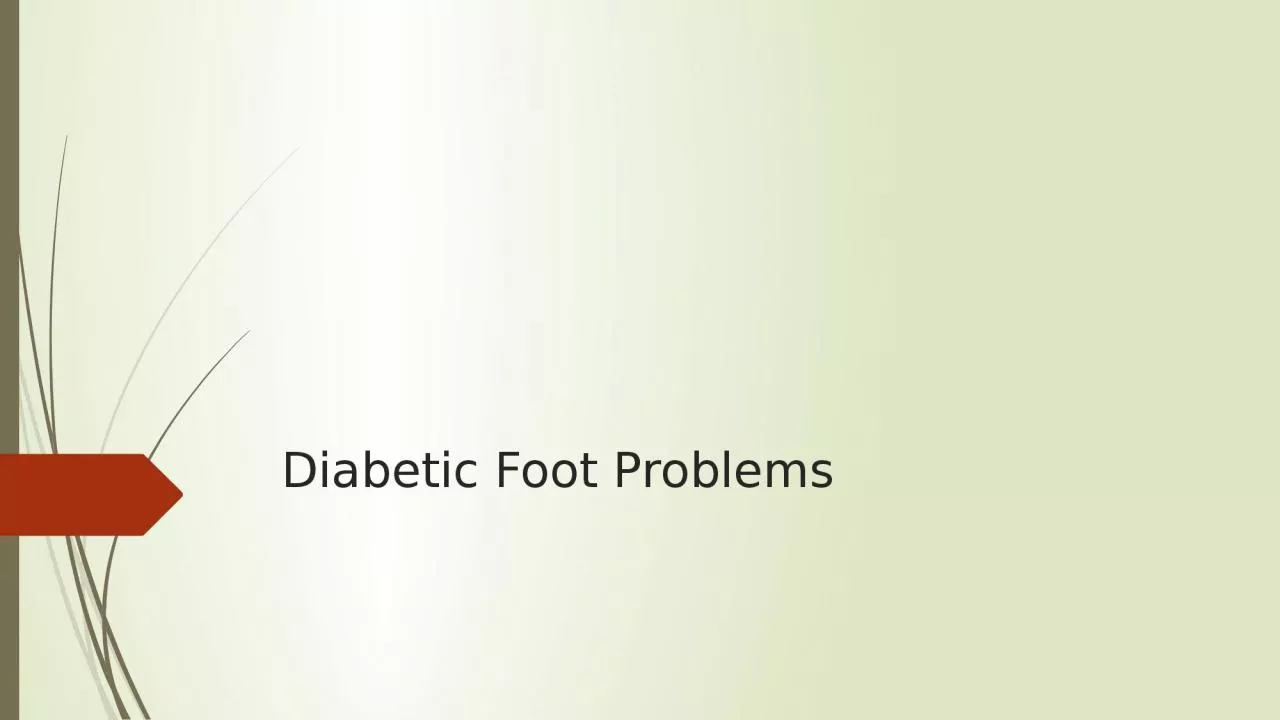

Common Diabetic Foot problems Diabetic Annual Foot review Vascular Foot Problems Referral Pathways Diabetic foot Introduction Diabetes mellitus is a group of metabolic diseases characterized by hyperglycemia resulting from defects in insulin secretion insulin action or both ID: 1015841
Download Presentation The PPT/PDF document "Diabetic Foot Problems Session Outline" is the property of its rightful owner. Permission is granted to download and print the materials on this web site for personal, non-commercial use only, and to display it on your personal computer provided you do not modify the materials and that you retain all copyright notices contained in the materials. By downloading content from our website, you accept the terms of this agreement.
1. Diabetic Foot Problems
2. Session OutlineCommon Diabetic Foot problemsDiabetic Annual Foot reviewVascular Foot ProblemsReferral Pathways
3. Diabetic foot IntroductionDiabetes mellitus is a group of metabolic diseases characterized by hyperglycemia resulting from defects in insulin secretion, insulin action, or both. The chronic hyperglycemia of diabetes is associated with long-term damage, dysfunction, and failure of various organs, especially the eyes, kidneys, nerves, heart, and blood vessels.Diabetic foot is defined as any foot pathology that results directly from diabetes or its long term complications
4. What Common foot problems have you heard of that are associated with Diabetes?
5. What Common foot problems have you come across so far?NeuropathySensory Motor AutonomicSkin – Callus / Corns / Infections (Fungal)IschaemiaAcute ChronicNeuro-ischaemiaUlceration / InfectionCharcot NeuroarthropathyPainful Peripheral Neuropathy
6. Which assessments could be performed?
7. Which assessments could be performed?Vascular – Check the blood flow to the feetNeurological – Check the nerve supply to the feetMedical History – Check for other associated medical conditionsSkin inspection – check for any skin damageFoot wear inspection – Are the shoes suitable?Biomechanical assessment – check how the patient is walkingWhy are these test necessary?
8. Diabetic foot ulcerationAround 5% of people with diabetes may develop a foot ulcer in any yearFoot ulcerations are the commonest cause of hospital admission in people with Diabetes Diabetic Foot Ulcerations are the most common cause of non-traumatic lower limb amputations.An associated amputation rate 15 fold higher than non diabeticsUp to 80% of these amputations are thought to be preventable – due to referral delays
9. What do NICE recommend?When examining the feet of a person with diabetes, remove their shoes, socks, bandages and dressings, and examine both feet for evidence of the following risk factors:NeuropathyLimb IschaemiaUlcerationCallusInfection / inflammationDeformityGangreneCharcot Arthropathy
10. Classifying the risk statusActive Ulceration / CharcotCritical limb Ischaemia / NecrosisNeuropathic PainPrevious UlcerationPrevious AmputationRenal replacement >1 risk factor1 risk factor – Ischaemia / Neuropathy / Deformity with CallusNo Risk factors
11. Patient educationEarly recognition of at risk footPrompt treatment of complicationsLOW RISKNo Risk factors presentnormal sensationpalpable pulsesGP practice based Foot care education&Annual reviewEmphasise importance of foot careCan progress to moderate riskNICE Guidelines. Diabetic Foot Problems: Prevention and management. 2015.
12. Patient educationEarly recognition of at risk footPrompt treatment of complicationsMODERATE RISK1 risk factor presentneuropathyor absent pulsesor other risk factorRefer to Foot protection service for Foot care education & Annual assessmentPodiatry review and treatment as neededAssess for revascularisation / treatment of painful neuropathyEvaluate footwear / insolesNICE Guidelines. Diabetic Foot Problems: Prevention and management. 2015.
13. Patient educationEarly recognition of at risk footPrompt treatment of complicationsHIGH RISKPrevious ulceration or amputation,renal replacement therapy more than 1 risk factor present. Refer to Foot protection service for Intensified foot care education & Annual assessmentPodiatry review and treatment as neededAssess for revascularisation / treatment of painful neuropathySpecialist footwear & insolesTreatment plan to reduce risk of ulcerationNICE Guidelines. Diabetic Foot Problems: Prevention and management. 2015. www.nice.org.uk
14. Patient educationEarly recognition of at risk footPrompt treatment of complicationsACTIVE DIABETIC FOOTULCER or CHARCOTUrgent referral to either Multidisciplinary Diabetic foot clinic within 24 hours or immediately if limb/life threatening – If vascular emergency refer straight to Hub At BrightonControl BM & other CVD risk factorsWound managementManage as high risk when ulcer healsRest & elevate affected footDebridementOff-loading/Dressings+/- Antibiotics Consider total contact castingNICE Guidelines. Diabetic Foot Problems: Prevention and management. 2015. www.nice.org.uk
15. Patient educationEarly recognition of at risk footPrompt treatment of complicationsLIMB THREATENING / LIFE THREATENING FOOT Ulceration with fever or any signs of sepsis. Ulceration with limb ischaemia (see the NICE guideline on lower limb peripheral arterial disease). Clinical concern that there is a deep-seated soft tissue or bone infection (with or without ulceration). Gangrene (with or without ulceration).NICE Guidelines. Diabetic Foot Problems: Prevention and management. 2015. www.nice.org.uk
16. Practice CasesCase 1You assess a person with Diabetes and find:Biphasic Pulses9/10 monofilamentRetracted toes and plantarCallusWhat is the risk category?Would you refer?Moderate Risk – Refer to the foot protection team Biomechanical assessment required
17. Practice CasesCase 2You assess a person with Diabetes and find:Triphasic Pulses9/10 monofilamentNo callus / deformitiesWhat is the risk category?Would you refer?Low Risk – remain under GP practice supervision
18. Practice CasesCase 3You assess a person with Diabetes and find:Biphasic Pulses6/10 monofilamentPlantar ulceration No signs of infectionWhat is the risk category?Would you refer?Active Foot – Refer to Diabetic Multidisciplinary Foot team
19. Practice CasesCase 4You assess a person with Diabetes and find:Biphasic Pulses0/10 monofilamentHot swollen footRecent traumaWhat is the risk category?Would you refer?Active Foot – Refer to Diabetic Multidisciplinary Team UrgentlyWithin 24 hours.
20. Practice CasesCase 5You assess a person with Diabetes and find:Monophasic Pulses4/10 monofilamentSome biomechanical issuesRecent osteomyelitis and healedWhat is the risk category?Would you refer?High risk – Refer to Foot protection team